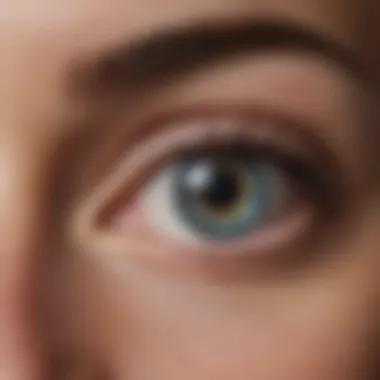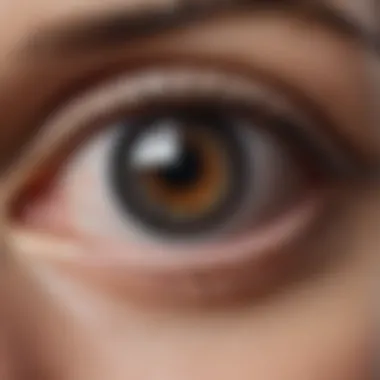Understanding Eye Pressure Units: Importance and Impact


Intro
Understanding eye pressure units is crucial for both the medical community and individuals seeking to maintain optimal eye health. Intraocular pressure (IOP) serves as a significant indicator of various ocular conditions, particularly glaucoma. Glaucoma can lead to irreversible vision loss if left untreated, making it necessary for regular monitoring of eye pressure. Grasping the details surrounding pressure measurement can help in the early detection and treatment of such conditions.
In this article, we will explore the fundamental aspects of eye pressure units, the methods utilized in measuring IOP, and the implications these measurements hold in diagnosing ocular diseases. By navigating current research findings, we aim to clarify the importance of understanding these units for professionals and the general public alike.
Methodology
Study Design
Research on eye pressure units generally integrates both qualitative and quantitative frameworks. This approach allows for comprehensive evaluation of measurement practices, as well as their clinical outcomes. The studies often review patient data, analyze measurement techniques, and investigate correlations between IOP readings and ocular health conditions.
Data Collection Techniques
Data collection in this area often involves multiple techniques:
- Tonometry: The most common method used to measure IOP. Devices such as Goldmann applanation tonometer and non-contact tonometers are employed.
- Visual Field Testing: To assess the extent of vision loss associated with elevated IOP.
- Optical Coherence Tomography (OCT): This imaging technique assists in observing structural changes in the eye due to increased pressure.
Utilizing a combination of these methods provides a well-rounded picture of intraocular pressure dynamics and its implications for eye health.
Discussion
Interpretation of Results
Interpreting IOP measurements is not straightforward as various factors can influence the results. Normal IOP ranges typically fall between 10 to 21 mmHg. Readings above this range may indicate the risk of glaucoma. However, individual variations due to corneal thickness, age, and other health conditions complicate this interpretation.
Limitations of the Study
One limitation in the research of eye pressure units is the limited diversity in patient demographics across studies. Furthermore, device calibration and measurement techniques can vary, leading to inconsistencies in reported IOP values, which can affect clinical conclusions.
Future Research Directions
Future investigations should focus on developing standardized practices for measuring IOP and integrating advanced technologies to enhance accuracy. Longitudinal studies may also offer insights into the progression of ocular diseases linked to fluctuating IOP levels, further informing preventative care and treatment strategies.
In summary, a solid understanding of eye pressure units is indispensable. It empowers healthcare professionals and patients to make informed decisions about eye health, ultimately aiding in the early detection and treatment of potentially devastating ocular conditions.
Preface to Eye Pressure
Intraocular pressure (IOP) plays a pivotal role in maintaining the health of the eye. Understanding eye pressure is not merely a technical exercise; it is essential for diagnosing, monitoring, and managing various ocular conditions. This section aims to clarify the significance of eye pressure measurements and their implications for eye health.
Defining Intraocular Pressure
Intraocular pressure refers to the fluid pressure within the eye. It is primarily influenced by the production and drainage of aqueous humor, the clear fluid that fills the front part of the eye. Normal IOP ranges typically lie between 10 and 21 mmHg, although individual variations exist. Elevated pressure can lead to conditions such as glaucoma, whereas low pressure can indicate other issues like hypotony. Accurate definitions and measurements provide a foundation for effective ophthalmic assessment and intervention.
Importance of Monitoring Eye Pressure
Monitoring eye pressure is crucial for several reasons. Regular eye examinations can detect changes in IOP, potentially identifying early signs of ocular diseases. Such monitoring becomes particularly important for individuals with risk factors like family history of glaucoma, high myopia, or diabetes.
"Regular eye pressure checks can prevent irreversible damage and preserve vision."
Consistent screening allows for timely interventions, which can mitigate the progression of diseases related to high or low IOP. Furthermore, evaluating the effectiveness of treatments for ocular hypertension or glaucoma hinges on understanding changes in eye pressure over time.
In summary, grasping the concept of eye pressure is integral to eye health. It informs both clinical practices and patient awareness, ultimately facilitating better outcomes for those at risk.
The Units of Eye Pressure Measurement
Understanding the units used for measuring eye pressure is crucial in assessing ocular health. It provides clarity on how pressure is quantified and helps in determining treatment approaches. This article will focus on the common units used: millimeters of mercury and others like centimeters of water and kilopascals. Each unit has specific characteristics, advantages, and implications when it comes to measuring intraocular pressure.


Millimeters of Mercury (mmHg)
Millimeters of mercury, or mmHg, is the standard unit for measuring eye pressure across the globe. It is derived from the height of a column of mercury that can be supported by the pressure exerted by the eye. The reason for using mercury is historical, dating back to early developments in barometry and has continued because of its precision and reliability.
The normal intraocular pressure range is typically 10 to 21 mmHg. Values outside this range may suggest potential issues such as ocular hypertension or hypotony. Clinicians universally understand this unit, making it an important standard in both research and clinical practice. The measurement in mmHg provides clear communication about a patient’s status, allowing for effective monitoring over time.
Other Measurement Units
While mmHg is widely accepted, other units also exist for measuring eye pressure. These can provide additional context in specific cases or regions. Among these are centimeters of water and kilopascals.
Centimeters of Water (cmO)
Centimeters of water is another unit of measurement sometimes used in clinical settings, particularly in some regions and specific studies. This unit quantifies pressure based on how high a column of water would rise under similar conditions. One of the key characteristics of centimeters of water is its simplicity and ease of understanding for non-expert audiences.
Using cmO can be beneficial when discussing measurements in a context more relatable to general pressure concepts. However, medical professionals need to convert these values to mmHg since the latter is the standardized unit in ophthalmology. The primary drawback lies in the potential for confusion unless proper conversions are clearly communicated, making it less popular than mmHg.
Kilopascals (kPa)
Kilopascals is another unit that might come up in occasional discussions concerning intraocular pressure. It is a unit of pressure derived from the International System of Units (SI) and represents force per unit area. The relationship between kPa and mmHg is linear, where 1 kPa is approximately equal to 7.5 mmHg.
Kilopascals can provide a modern and scientific context for measuring pressure and is used in research environments focusing on advanced methodologies. However, for practical applications in clinics, mmHg remains the preferred choice due to its long-standing history and clinical familiarity. The main advantage of kPa is its alignment with other scientific measurements that use SI units, creating a broader context for those familiar with such systems.
In summary, while mmHg reigns as the dominant standard in eye pressure measurement, the understanding of other units like centimeters of water and kilopascals is useful in certain contexts. Each unit carries implications not just for clinical accuracy but also for patient communication and understanding.
Methods of Measuring Eye Pressure
Measuring eye pressure is a critical aspect of ophthalmology and optometry. Understanding the various methods available is important for accurate assessment of intraocular pressure (IOP). Each method comes with its unique features and considerations. Utilizing the right technique ensures better diagnosis and management of eye conditions, particularly glaucoma.
Tonometry: The Gold Standard
Tonometry is regarded as the gold standard for measuring intraocular pressure. It provides reliable data essential for evaluating the risk of ocular diseases.
Applanation Tonometry
Applanation tonometry is a widely used method, particularly in clinical settings. This technique involves flattening a small area of the cornea to assess the pressure inside the eye. A key characteristic of applanation tonometry is its accuracy. This method has been extensively validated and is recommended in various guidelines.
The main advantage of applanation tonometry is its ability to provide consistent measurements. However, it can be less comfortable for patients. The need for corneal contact might introduce variability. Despite these concerns, its reliability makes it a popular choice among eye care professionals.
Non-Contact Tonometry
Non-contact tonometry offers an alternative by measuring eye pressure without touching the eye. This method uses a puff of air to flatten the cornea. Its main appeal lies in comfort and ease of use for patients. There is no risk of corneal abrasion, which often occurs with contact methods.
The unique feature of non-contact tonometry is its speed. This method provides quick readings, making it suitable for mass screenings. On the downside, it may be less accurate in certain cases. Because it relies on air puff technology, external factors like corneal shape can affect readings.
Alternative Techniques
Beyond tonometry, there are other measurement techniques for intraocular pressure.
Dynamic Contour Tonometry
Dynamic contour tonometry provides a different approach by measuring pressure based on the contours of the cornea. This method accounts for individual corneal thickness and shape. A key characteristic is its ability to provide true IOP readings, making it advantageous in glaucoma assessments.
Its unique feature lies in how it adapts to variations in corneal properties. However, the complexity of the device and the need for specific training for operators can limit its use in some practices.
Rebound Tonometry
Rebound tonometry is another modern method for measuring eye pressure. It involves a small, lightweight probe that briefly contacts the cornea. A significant advantage of rebound tonometry is its portability and ease of use. This makes it an excellent choice for use in various settings, including home monitoring.
The unique feature of rebound tonometry is its non-invasive nature. The measurements are quick, reducing the discomfort associated with traditional methods. However, its accuracy can be influenced by factors like corneal sensitivity and patient cooperation, which may limit its reliability in some cases.


Understanding these methods of measuring eye pressure is crucial for effective diagnosis and management of ocular conditions, including glaucoma. Each technique has distinct advantages and limitations, which must be considered when choosing the appropriate method.
Interpreting Eye Pressure Readings
Interpreting eye pressure readings is crucial for understanding the overall health of the eye. It provides insights into various ocular conditions, helping in diagnosis and treatment plans. Knowledge of these readings can aid medical professionals and patients alike in making informed decisions regarding eye care. Accurate interpretation can lead to the early identification of diseases that impact vision and overall quality of life.
Normal Pressure Ranges
Normal intraocular pressure typically ranges from 10 to 21 mmHg. This range offers a baseline that occludes potential issues. Factors affecting these readings include time of day, medications, and individual physiological differences. The standard classification helps guide further investigation, ensuring those within this range need not face unnecessary anxiety. Any significant deviations can prompt further exploration into the underlying causes. These might include systemic factors or anatomical variations in the eye.
Elevated Eye Pressure (Ocular Hypertension)
Elevated intraocular pressure, commonly known as ocular hypertension, is when pressure readings exceed 21 mmHg. It is a significant risk factor for glaucoma, a condition that can lead to vision loss. Not all individuals with elevated pressure will develop glaucoma, but the risk increases with higher levels and additional factors, such as age and family history. Regular monitoring and management strategies are paramount. Treatment options include medications, laser therapy, or surgical approaches, depending on the severity and persistence of elevated readings. Understanding individual readings allows for tailored therapeutic interventions, reducing the risk of complications.
Low Eye Pressure (Hypotony)
Low eye pressure, or hypotony, is characterized by intraocular pressure readings of less than 10 mmHg. This condition can lead to various complications, including vision impairment and structural changes in the eye. It often results from surgical interventions, trauma, or certain diseases. A careful approach is essential in managing hypotony, as the underlying cause must be identified for effective treatment. Adjustments in therapy or preventive measures may be necessary to stabilize the pressure. Monitoring becomes vital to ensure recovery and the maintenance of ocular health.
Regular check-ups and proactive management are crucial in maintaining optimal eye pressure and preventing severe complications.
The Role of Eye Pressure in Glaucoma
Understanding the role of eye pressure is critical in discussing glaucoma. This condition is one of the leading causes of irreversible blindness worldwide. Elevated intraocular pressure (IOP) is often a significant risk factor for glaucoma. By exploring this connection, we can grasp how monitoring IOP can help in early detection and management of the disease. It is important to understand that not everyone with high IOP will develop glaucoma; however, for many, it remains a key indicator of disease progression.
Link Between Intraocular Pressure and Glaucoma
The relationship between elevated intraocular pressure and glaucoma is complex. In glaucoma, increased IOP can lead to damage to the optic nerve, resulting in vision loss. Research shows that for most types of glaucoma, particularly primary open-angle glaucoma, IOP is a major modifiable risk factor. Maintaining eye pressure within a normal range may halt further damage and even prevent the disease's onset in some individuals.
- Normal IOP ranges generally fall between 10 and 21 mmHg.
- Elevated IOP typically refers to measurements greater than 21 mmHg.
- Risk Assessment: Patients with elevated IOP need thorough evaluation for glaucoma, along with tests to assess optic nerve health and visual fields.
Despite the established link, not all individuals with elevated eye pressures develop glaucoma. Some may experience high IOP without any optic nerve damage. This condition is known as ocular hypertension. Thus, while IOP monitoring is critical, it is not the sole determinant of a glaucoma diagnosis.
Monitoring and Treatment Implications
Monitoring IOP is vital for both diagnosing and managing glaucoma. Regular check-ups can help determine if a patient is at risk. Many professionals will use tonometry methods to measure eye pressure periodically. Early detection is paramount to preserving vision. When IOP readings indicate risk, treatment options can be considered, including medications or surgical interventions.
Management approaches can include:
- Medications: Eye drops like prostaglandin analogs or beta-blockers are commonly prescribed to lower IOP.
- Laser Therapy: Procedures like selective laser trabeculoplasty may help enhance fluid drainage from the eye.
- Surgery: When other methods fail, surgical options are available to create new drainage pathways or improve existing ones.
"The goal in managing glaucoma is not only to lower IOP but also to protect against optic nerve damage."
In summary, understanding the role of eye pressure in glaucoma provides insights into both diagnosis and treatment. Effective monitoring of IOP is necessary for managing this potentially blinding condition. By acknowledging the nuances between IOP, ocular hypertension, and glaucoma, healthcare professionals can better serve their patients, leading to improved eye health outcomes.
Factors Influencing Eye Pressure
Understanding the factors that influence eye pressure is crucial for grasping its implications on overall eye health. Various elements contribute to fluctuations in intraocular pressure, and recognizing these can aid both patients and healthcare professionals in better managing ocular conditions. Monitoring these factors can help in the early detection of potential issues, which is particularly vital for diseases like glaucoma.
Natural Fluctuations in Eye Pressure
Intraocular pressure is not constant; it naturally fluctuates throughout the day. These fluctuations are influenced by several biological patterns, including circadian rhythms. Studies have shown that eye pressure tends to be lower in the early morning and can peak in the late afternoon or early evening. Understanding this can aid in interpreting pressure readings accurately during clinical examinations.
Factors leading to these fluctuations can include:
- Eye position: Changes in head position can momentarily affect fluid drainage from the eye.
- Body posture: Lying down versus sitting can impact intraocular pressure as it alters how aqueous humor circulates within the eye.
- Diurnal variations: Hormonal changes across the day may create natural peaks and troughs in measurements.
Impact of Medications
Medications can significantly influence intraocular pressure, either positively or negatively. Certain pharmaceutical agents are designed to lower eye pressure, aiming to mitigate risks associated with elevated intraocular pressure, particularly in patients with glaucoma. Examples include topical prostaglandins like Latanoprost and beta-blockers like Timolol.


Conversely, there are medications that can increase eye pressure, such as corticosteroids. Their use, especially systemic forms, can lead to a rise in intraocular pressure, necessitating careful monitoring. Thus, understanding the types of medications a patient is using is paramount in assessing their risk levels for pressure-related complications.
Lifestyle and Environmental Factors
Lifestyle choices and environmental conditions can portray a substantial impact on eye pressure as well. For example, high caffeine intake has been associated with transient increases in intraocular pressure. Besides, stress levels can play a role. Chronic stress may contribute to overall health decline, which can include fluctuations in eye pressure.
Other factors can include:
- Diet: A balanced diet rich in antioxidants may help maintain healthy eye pressure levels. For instance, foods high in omega-3 fatty acids are beneficial.
- Exercise: Engaging regularly in physical activities can contribute to lowering eye pressure. Moderate aerobic exercise is particularly effective.
- Travel and altitude changes: Elevation can lead to noticeable changes in eye pressure due to how fluid behaves under different gravitational pulls.
In summary, multiple components—ranging from natural biological rhythms, medications, lifestyle choices, and environmental factors—all contribute to the dynamics of intraocular pressure. Recognizing these influences is essential for effective monitoring, particularly in individuals at risk for glaucomatous changes. Assessing the cumulative weight of these factors will enable healthcare providers to recommend better management strategies tailored to individual patient needs.
"The understanding of eye pressure intricacies extends beyond standard measures—context and individual variations matter greatly in effective eye health management."
By analyzing these influences, both patients and medical professionals can improve awareness and enhance preventive measures for maintaining optimal ocular health.
The Future of Eye Pressure Measurement
The future of eye pressure measurement holds considerable promise, as advancements in technology offer new methods to assess and monitor intraocular pressure more effectively and conveniently. These innovations address the growing need for precise and frequent eye pressure evaluations. Patients with conditions like glaucoma require vigilant monitoring, and traditional methods may not always suffice. Therefore, looking ahead, we can expect to see significant shifts in both the tools available for measurement and the manner in which these measurements are conducted.
Innovations in Tonometry
Recent years have witnessed remarkable progress in the field of tonometry. Traditional methods, such as applanation tonometry, remain foundational, but innovations are providing alternatives that enhance accuracy and patient comfort. New techniques involve the use of advanced sensors and imaging technologies.
- Dynamic Contour Tonometry: This method evaluates eye pressure in real-time, adapting to the contour of the cornea. It provides a more precise pressure reading by minimizing corneal indentation effects, which can skew results in conventional measurements.
- Rebound Tonometry: Using a lightweight probe, rebound tonometry measures eye pressure based on the rebound of a small device against the cornea. This approach is non-invasive and quick, which encourages more frequent testing in clinical settings.
The integration of these innovative methods into routine eye exams may lead to deeper insights into intraocular pressure variations, allowing better management of conditions like glaucoma.
Wearable Technology and Remote Monitoring
The rise of wearable technology is reshaping how health metrics are tracked, and intraocular pressure is no exception. With the growing trend of health monitoring devices, researchers are exploring ways to implement similar technology for eye pressure assessment.
- Remote Monitoring: Wearable devices may allow patients to continuously monitor their eye pressure from home. Such solutions can transmit data directly to healthcare providers, ensuring timely interventions are possible based on actual pressure readings rather than scheduled visits alone.
- Smart Glasses: Concepts for smart glasses that can measure eye pressure present intriguing possibilities. If developed, these devices could provide real-time readings, integrating seamlessly into daily life.
As these technologies advance, considerations about data privacy, accuracy, and the need for regulatory approval will be essential. The future of eye pressure measurement promises to be more accessible, allowing for improved patient outcomes and more effective management of ocular health conditions.
"With these technological advancements, we may ultimately achieve an era where eye pressure monitoring becomes as routine as checking heart rate or blood sugar levels."
In summary, the developments in tonometry and the emergence of wearable technology pave the way for innovative solutions in eye pressure measurement. These advancements could transform patient care, making proactive management of eye health more practical than ever.
Closure
The conclusion serves as a critical reflection on the complexities and implications of eye pressure units. This article has provided an in-depth exploration of intraocular pressure, its measurement, and its significance in maintaining ocular health. Understanding the different units of measurement, such as millimeters of mercury and other alternatives, is essential. It informs not only medical professionals but also patients about their conditions and potential treatment paths.
In keeping with advances in technology, the focus on innovative measurement techniques and wearable devices cannot be overstated. These developments offer promises of enhanced monitoring capabilities, leading to more personalized and effective management of eye health.
The importance of regular monitoring of eye pressure cannot be underestimated. Elevated levels may indicate potential eye conditions such as glaucoma, making early detection critical to preserving vision.
In summary, knowledge about eye pressure units is crucial for a comprehensive understanding of eye health. Patients equipped with this understanding can engage more actively in their care, ensuring better health outcomes overall.
Summarizing Key Insights
Several key insights emerge from this discussion:
- Intraocular pressure (IOP) is a cornerstone metric in assessing ocular health.
- The most common unit of measurement for eye pressure is millimeters of mercury (mmHg), but awareness of other units like centimeters of water (cmO) and kilopascals (kPa) is beneficial.
- The methods of measuring IOP, primarily tonometry, are advancing alongside technology.
- Elevated IOP has direct correlations with conditions like glaucoma, emphasizing the need for regular monitoring.
Understanding these elements equips patients and healthcare providers with the necessary knowledge for proactive management of eye conditions.
Encouraging Further Research
Looking forward, further research is essential in several areas related to eye pressure measurement and its implications.
- Innovative technologies such as remote monitoring devices provide a promising avenue for dynamic IOP assessment.
- Studies focusing on the relationship between environmental factors and fluctuations in IOP will help contextualize eye health in daily life.
- Assessing the long-term effects of pharmaceuticals on IOP can refine treatment protocols for various eye conditions.
Emphasizing the importance of advancing our understanding amidst a rapidly evolving field reinforces the necessity for ongoing inquiry. As the landscape of ocular health continues to shift, so too must our approaches to measuring and interpreting eye pressure.







